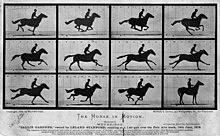During his time recuperating in England he took up professional photography, learning the wet-plate collodion process, and secured at least two British patents for his inventions. He went back to San Fransisco in 1867, and in 1868 his large photographs of Yosemite Valley made him world-famous. In 1875 he travelled for more than a year in Central America on a photographic expedition. In the 1880s, he entered a very productive period at the University of Pennsylvania in Philadelphia, producing over 100,000 images of animals and humans in motion, capturing what the human eye could not distinguish as separate movements.
Muybridge spent his later years giving public demonstrations and teachings of his photography and early motion picture sequences, travelling back to England and Europe to publicise his work. He also edited and published compilations of his work, which greatly influenced visual artists and the developing fields of scientific/industrial photography. In 1894, he returned back to England permanently, then shortly in 1904, the Kingston Museum was opened in his hometown and contained a collection of his equipment.
 In 1872, the former businessman and race-horse owner, hired Muybridge for some photographic studies. He had taken a position on a popularly debated question "whether all four feet of a horse were off the ground at the same time while trotting." In 1872, Muybridge began experimenting with an array of 12 cameras photographing a galloping horse in a sequence of shots. The human eye could not break down the action at the quick stride of the trot and gallop. Up until this point of discovery, most artists painted horses at a trot with one foot always on the ground, and at a full gallop with the front legs extended to the rear, and all feet off the ground. So Muybirdge was hired to prove this question. Between 1878 and 1884, Muybridge perfected his method of horses in motion, proving that they do have all four hooves off the ground during their running stride. In 1872, Muybridge settled Stanford's question with a single negative showing the horse airborne at the trot.
In 1872, the former businessman and race-horse owner, hired Muybridge for some photographic studies. He had taken a position on a popularly debated question "whether all four feet of a horse were off the ground at the same time while trotting." In 1872, Muybridge began experimenting with an array of 12 cameras photographing a galloping horse in a sequence of shots. The human eye could not break down the action at the quick stride of the trot and gallop. Up until this point of discovery, most artists painted horses at a trot with one foot always on the ground, and at a full gallop with the front legs extended to the rear, and all feet off the ground. So Muybirdge was hired to prove this question. Between 1878 and 1884, Muybridge perfected his method of horses in motion, proving that they do have all four hooves off the ground during their running stride. In 1872, Muybridge settled Stanford's question with a single negative showing the horse airborne at the trot.



No comments:
Post a Comment